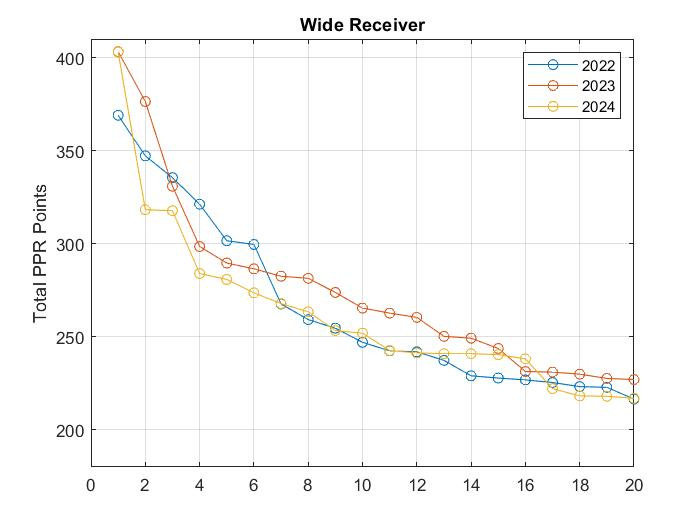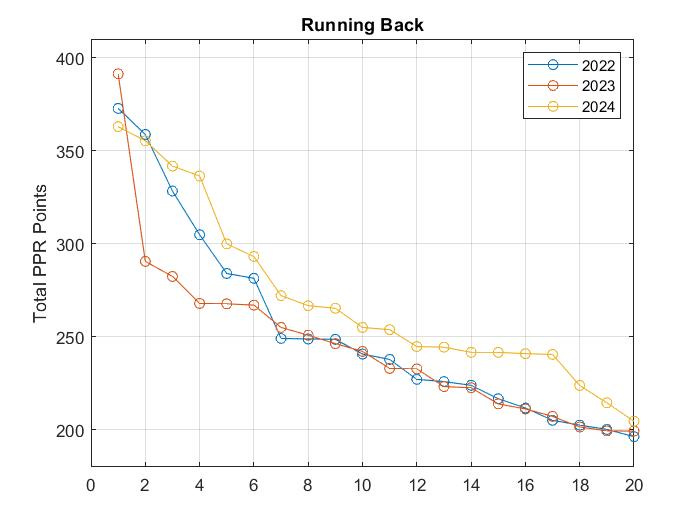I can recall back just a few months ago, back when we were making the regular weekly start/sit decisions, choosing between Jaylen Waddle and Brian Robinson, or Deebo Samuel and Rico Dowdle. If you would’ve told me at the start of the season Rico Dowdle would be scoring enough fantasy points to compete for a spot in my starting lineup over Deebo Samuel I would’ve looked at you sideways.
This isn’t just me hand picking names either. 2024 was a weird year for fantasy football and it can be difficult to sift through the results without being too reactionary. Running backs took the cake, and receivers were left eating scraps. So should we just flip our previous strategies upside down? Does Zero RB become Zero WR? Or maybe Hero WR, draft Ja’Marr Chase or Justin Jefferson, then hammer RB from then on?
Now that I’ve had a few months to digest, I’ll explore some of my thoughts on why 2024 was a both and outlier year and what we should expect going forward.
2024 was the perfect storm for success at the RB position. That won’t necessarily be the case again in 2025. Let’s start by looking at some high level numbers. From a league wide perspective, nothing stands out that says RBs dominated. Over the last three seasons, the macro level data doesn’t highlight anything that would indicate why running backs were so good in fantasy.
2022-2024 League Wide Averages
Yards per carry: 4.5, 4.2, 4.4
Rushing yards per game: 121.6, 112.7, 119.8
Rushing touchdowns per game: 0.9, 0.9, 0.9
Last summer I shared a piece called The case for WAR, which despite the ominous title, I was reflecting on how the different positions are valued and why you should be drafting WRs early. Looking back over a longer timespan, though, 2023 was an outlier year in it’s own right, but for WRs instead.
Outside of WRs 3-6, you can clearly see the position had it’s best year in 2023. This pushed up WR prices heading into 2024 drafts. I didn’t help in that regard. I was preaching that there was a big drop off after the top 3 RBs, and to draft WRs early. A big miss on my part.
So while what Saquon did last season was special, relative the past few seasons, it didn’t even match McCaffrey in 2023, or Austin Ekeler in 2022. The outliers come as you move down the list. The RB4 in 2024, Derrick Henry was wayyy better than past seasons, so was the RB5, RB6, and so on. It’s not even close. It was simply just an incredibly good year to have running backs in fantasy.
But like we saw after the outlier WR season in 2023, I wouldn’t be surprised if RBs are dominating early ADP once draft season rolls around. So the big question is, “should we be drafting RBs early?”
#1 — Rookies
According to NFL mock draft database, consensus has 9 running backs in the top 100. This is shaping up to be a historically good RB class. Last year that number was just 4, with Jonathon Brooks being the only player inside the top 50 and he hardly saw the field due to injury. 2025 could easily see more RBs drafted in the top 50 than there were in the first three rounds combined last year.
This is relevant because the veterans didn’t have their jobs threatened by a wave of new talent, so they were able to maintain that all important volume element to sustain fantasy scoring. Bucky Irving and Tyrone Tracy were really the only rookies we can reflect on in glowing terms, and those two in particular had the benefit of backfields that were ripe for opportunity. The earlier drafted guys, like Blake Corum and Trey Benson, were tasked with overcoming known studs in Kyren Williams and James Conner.
The TL;DR is I don’t expect many players to be safe from welcoming competition, so we should expect at least a few RB rooms to be shaken up heading into the 2025 season.
I’ll cover these rookies in more detail once we know draft capital and landing spots.
#2 — Free Agents
In addition to the previous point about the 2024 rookie RB class being weak, the group of 2024 free agent running backs was flooded with stars. Saquon Barkley is the first name that comes to mind for many, making the switch within the NFC East from the Giants to the Eagles and immediately winning a championship, but he wasn’t the only one. We had Derrick Henry, Josh Jacobs, Tony Pollard, JK Dobbins… you get the idea.
In almost every case, the running back making a move, saw an improvement in offensive situation, and we as fantasy managers didn’t properly account for that. Every single one of Saquon (Giants —> Eagles), Jacobs (Raiders —> Packers), Henry (Titans —> Ravens), stepped into an ideal situation. They performed like first round picks while being drafted in the second and third rounds.
Front offices are sharp. I believe these teams were looking ahead knowing there weren’t many strong prospects and decided to address their RB rooms in free agency. Actually, most teams did both, but there wasn’t enough talent in the draft class to earn more than a backup role.
Again, like the rookies, this point is shaping up to be the opposite from last year. We have an extremely strong draft class paired with a weak free agent class. Aaron Jones and Najee Harris headline the group, but the talent behind them is looking thin.
The impact this has on fantasy, though, is understated. When Saquon or Jacobs swapped cities, we already knew they were good players, so the only question mark was their role. We were comfortable drafting many of those free agents in rounds 2 and 3. At the same time, I expect those same players to be drafted even higher next season based on what we just saw from them.
If the winners of 2024 get pushed up as expected, the rookies will naturally get pushed down. I doubt we’ll see many 2nd or 3rd round rookie RBs in fantasy drafts, outside of Ashton Jeanty and maybe Omarion Hampton, because we haven’t seen them do it before. So, as I like to say, uncertainty creates opportunity. We shouldn’t avoid drafting these players just because we haven’t seen them play in the NFL. Again, more to come on them post-draft and in the RB dead zone content.
#3 — Injuries
The top 24 running backs (by ADP) in 2024 played an average of 13.5 games. In a 17 game fantasy season, considering each player has a bye week, the average running back missed just 2.5 games. Meanwhile, the top 24 wide receivers played an average of 13.1 games.
The difference from 13.5 to 13.1 doesn’t seem like a lot. Less than half a game. But I think it requires looking a little deeper.
Another way of looking at it, only 5 RBs with top 24 ADP finished outside the top 24. They were predictable and healthy for the most part.
Meanwhile, 10 WRs with top 24 ADP finished outside the top 24, many of them due to injury. Nico Collins finished WR26 but was WR7 in PPG. Cooper Kupp finished WR36 but was WR23 in PPG. Chris Godwin only played 8 games but was WR9 in PPG, and Rashee Rice only played 4 games but was WR14 in PPG. Outside of a few names at the top, they were much less predictable. Or their health was.
The entire thesis behind Zero RB draft strategy hinges on this — when a running back misses time, their replacement production is both easier to acquire and easier to predict.
Of those top 24 RBs by ADP, there were three who failed to play at least 10 games. Christian McCaffrey, Isiah Pacheco, and Zamir White. Zamir White isn’t a great example because he didn’t really miss time due to injury, he just wasn’t good. But McCaffrey’s backup for most of the season, Jordan Mason, averaged 13.6 points while CMC was out. Likewise, Kareem Hunt averaged 15.4 points while Pacheco was out.
There were also three WRs from the group that didn’t get to 10 games played. Chris Olave, Brandon Aiyuk, and Stefon Diggs. Ironically, their teammates were also injured throughout much of the season (Rashid Shaheed, Tank Dell, Deebo Samuel). So what, are we supposed to start Marquez Valdes-Scantling and John Metchie? The backup WRs are not startable in fantasy.
All three points above: the rookie class, the free agents, and injuries are not constants. It was the perfect storm. Of course, it’s easier to look back in hindsight how this shaped the fantasy landscape in 2024. I think there’s a lesson to be learned, though, and if other fantasy managers want to react to the data without looking at the big picture, I will welcome it. That allows us to spot players, or even entire positional groups, that may be mispriced.
We’ll keep this in our back pocket and remember 2024 was an outlier year. We can use this to our advantage.





